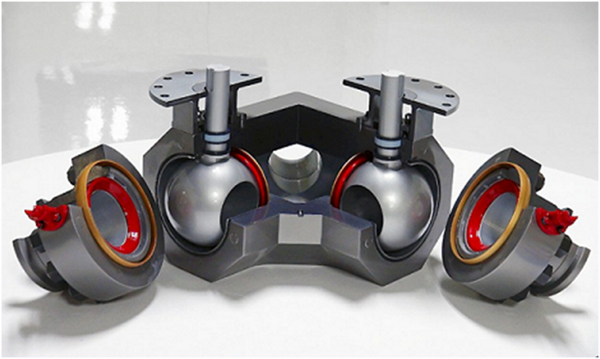![[3D printed ball valve [Source: Valve Magazine ]](https://fabbaloo.com/wp-content/uploads/2020/05/Valve-Image1_img_5eb0a3e99e467.png)
Charles Goulding and Tyler Gianchetta of R&D Tax Savers discuss 3D printing and valves.
Valves are core manufacturing components that continue the passage of air or fluids through a pipe or duct. As 3D printing technology continues to improve, so too does its extensive list of applications and possibilities – a list that now includes groundbreaking improvements in the methodologies for valve manufacturers to develop and refine their products and processes.
The Research & Development Tax Credit
Enacted in 1981, the now permanent Federal Research and Development (R&D) Tax Credit allows a credit that typically ranges from 4%-7% of eligible spending for new and improved products and processes. Qualified research must meet the following four criteria:
-
Must be technological in nature
-
Must be a component of the taxpayers business
-
Must represent R&D in the experimental sense and generally includes all such costs related to the development or improvement of a product or process
-
Must eliminate uncertainty through a process of experimentation that considers one or more alternatives
Eligible costs include U.S. employee wages, cost of supplies consumed in the R&D process, cost of pre-production testing, U.S. contract research expenses, and certain costs associated with developing a patent.
On December 18, 2015, President Obama signed the PATH Act, making the R&D Tax Credit permanent. Beginning in 2016, the R&D credit can be used to offset Alternative Minimum tax for companies with revenue below $50MM and for the first time, pre-profitable and pre-revenue startup businesses can obtain up to $250,000 per year in payroll taxes and cash rebates.
GE Oil & Gas
GE Oil & Gas has implemented the most cutting-edge metal laser sintering hybrid milling machines at its facility in Japan. The Kariwa plant utilizes the LUMEX Avance-25 metal 3D printer, manufactured by Matsuura Machinery Corporation, and holds the distinct honor of being the first plant in the world to combine additive manufacturing processes using a fiber optic laser and milling processes by a machining center into one unit.
These high-end 3D printers have provided substantial benefits in the manufacturing of their Masoneilan control valve parts, and allowed GE to add special configurations that can be utilized across various applications in the energy industry. Aside from overall time-saving and cost-cutting benefits, the use of 3D printing opens up brand new possibilities that traditional valve manufacturing methods could never achieve. A prime example of these newfound possibilities is the ability to manufacture control valve parts with more complex shapes, including hollow structures, curved shapes, and meshes, which are incredibly difficult or sometimes outright impossible to construct using conventional means, thereby allowing for substantial improvements in design freedom. 3D printing also allows for the construction of integrated molding, which reduces the number of steps for processing mold dies and subsequently yielding faster development cycles and lower manufacturing costs. Specially shaped components that would have otherwise taken three months to manufacture can now be designed in a matter of two weeks.
Aidro Hydraulics
The Italian hydraulics manufacturer Aidro has also introduced additive manufacturing methods to bring forth a new generation of hydraulic solutions and overcome the limitations of conventionally-manufactured components. The versatility of 3D printing technology has promoted faster lead times and increased performance and reliability of the parts, as well as the ability to design and print customized solutions with complex geometries. The lightweight and compact hydraulic products can integrate multiple parts into a single component, making additive manufacturing an invaluable asset for constructing small quantities of parts for specific applications.
![Aidro’s 3D hydraulic valve block printed in stainless steel for controlling a single-acting cylinder [Source: Aidro ]](https://fabbaloo.com/wp-content/uploads/2020/05/Valve-Image2_img_5eb0a3ea2937b.png)
Aidro has taken the initiative to develop metal 3D printed valves and blocks, with prototypes being completed in mere hours. The above image is just one example of the results that Aidro’s innovative design approach can yield. The valves can be connected in a myriad of different places and the internal channels have been specially designed to optimize flow and space savings. Their 3D printing strategies have also completely eliminated the potential for leakage because auxiliary drilling is no longer a necessary step in the development process.
3D printing has proven to be an incredibly valuable resource for developing smaller volumes of complex hydraulic components in an economical and efficient manner. It enables the printing of different models of the same prototype simultaneously, as well as significantly accelerating the process of testing, which can take 30-60 days for CNC machining or 6-12 months for casting, while 3D printing allows hydraulic components to be tested in a matter of days. Even if the printed parts require additional tooling, the lead time may only increase by a week or two, which is still drastically quicker than CNC machining or casting methods.
Another specific test case featured a stackable valve body that was redesigned for 3D printing in order to achieve a lightweight hydraulic valve. After undergoing testing and comparisons, it was verified that additive manufacturing enabled a reduction in the overall final weight of the valve by 60%, which also substantially cut production cost because less material was required for the valve’s construction.
![A 3D printed stainless steel hydraulic valve created by Aidro [Source: Aidro ]](https://fabbaloo.com/wp-content/uploads/2020/05/Valve-Image3_img_5eb0a3ea8c85c.png)
Conclusion
With the passage of time comes necessary innovation, and 3D printing has demonstrated its value as a pivotal player in the evolution of numerous manufacturing areas, and valves are no exception. As the valve manufacturing industry continues to grow, additive manufacturing processes will undoubtedly continue to bolster this growth into the foreseeable future.











A blog post reveals much of what happens behind the scenes at 3D print service Shapeways.